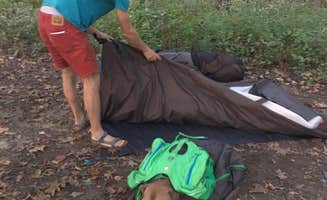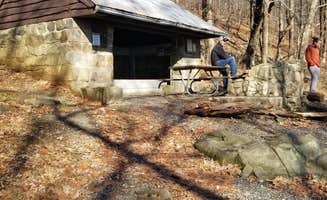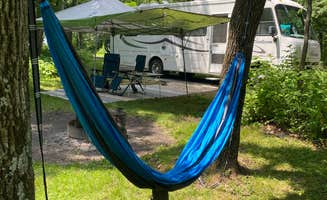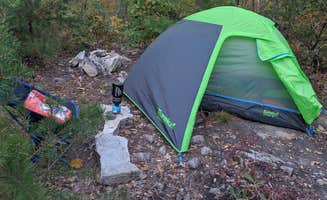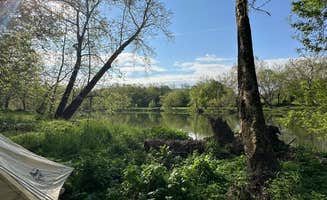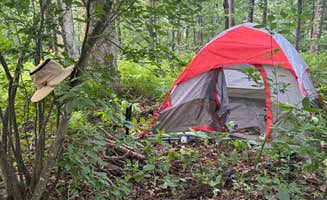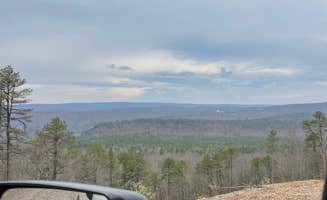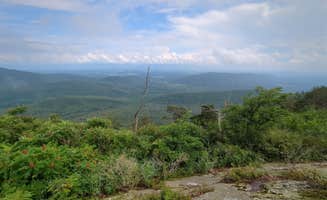Dispersed camping near Marshall, Virginia offers backcountry experiences across elevations ranging from 500 to 3,000 feet. The area features multiple forest zones where vegetation and wildlife vary dramatically with elevation changes. Spring runoff creates challenging creek crossings at many sites, with some requiring hiking boots or water shoes during April and May.
What to do
Hike to ridge views: At Veach Gap, camp along the ridgeline after a challenging 4-mile trek with 1,200 feet of elevation gain. "Breathtaking views of the Shenandoah River and surrounding mountains. Very much worth the 4 mile hike up to the site," notes TJ W. The trail requires adequate water supplies as there's "no water after the first mile."
Explore forest trails: Little Fort Campground provides access to wooded trails with creek access. "Nice flat camp site with picnic table and fire pit. Comes with tent pad but surface is too hard to use pegs," explains Zack B. The area features "a couple small trails around the area not any great views but it is very peaceful in the woods."
Creek and river activities: Fishing and swimming opportunities exist at multiple riverside camps. "Our site was amazing! The very last car camping site on the road. We were right on the river, we swam and fished," reports Justine I. about her experience at the South Fork Shenandoah River site. Some locations offer boat ramps for launching kayaks and canoes.
What campers like
Secluded backcountry sites: The Shenandoah National Park Dispersed Sites appeal to hikers seeking solitude. "These sites are backcountry meaning they are not established sites. You just wander down the trail and pick your favorite spot with consideration to not disturbing as much nature as possible," explains Stephanie R. Many enjoy the natural soundtrack: "I got to sleep listening to a river all night."
Accessible primitive camping: Crisman Hollow Road Camp offers drive-in sites without reservation requirements. "A bit dirty but awesome spot near a creek," reports Roger V. The area provides "many spots right on the water" with "one really nice hiking trail by the bridge," according to Waseem H.
Wildlife encounters: Animal sightings enhance the camping experience throughout the region. At the Laurel Prong Trail, Allan M. recounts: "Bears were constantly checking out our tent during night... after one bear sniffed that sucker out 15 minutes later while we were in our tent we heard the first one full sprint and slobbering to check it out." Proper food storage becomes essential in these encounters.
What you should know
Site selection logistics: Many dispersed camping areas use informal systems. At Little Fort, "You select a campsite by flipping a washer on a hook on the board from green to red. Flip it back when you leave," explains A Dan. Arrive early for prime locations: "We got the last spot around 7pm," notes Sawyer B.
Limited services: Pack accordingly for minimal facilities. "There's no running water here... nowhere to dump trash, pack it out when you leave," advises A Dan at Little Fort. At Wolf Gap Recreation Area, expect "vaulted toilet and communal garbage receptacle" but no water sources.
Cell service limitations: Communication options vary widely by location. "On this app it says T-Mobile access, I'm a T-Mobile customer, no reception at all but drive 5 minutes back down the mountain and you're good to go," reports A Dan. Another camper notes: "I captured one bar of cellular on AT&T" at Wolf Gap, while others report complete service blackouts.
Tips for camping with families
Campsite selection: Choose established sites for easier family camping. Wolf Gap offers organization with "paved parking platform and then a second tier for the camp site. All sites are quite large and include picnic tables, fire rings and large tent platforms," reports Kevin C.
Trail difficulty planning: Assess trail conditions before hiking with children. The Laurel Prong Trail was "listed as moderate hike and easy camping. I think, just like some others on the list, the easy camping might be a slight exaggeration," warns Nora S. Research current conditions before setting out.
Safety preparations: Wildlife encounters require planning with children. Bears are active in many areas, especially at established sites. Proper food storage is critical, and families should practice bear safety protocols together before arrival.
Tips for RVers
Size limitations: Most dispersed sites accommodate only smaller recreational vehicles. South Fork Shenandoah River has limited drive-in access: "We stayed right at the end of the road, since we have a 30 foot RV, but there are sites you can walk to all the way down the river," notes Justine I.
Road conditions: Access roads often deteriorate after rainfall. "The road was a little rough, but our 92 ford camper made it, just go slow," advises Justine I. At Squirrel Hollow Road Camping, sites are "located less than a mile from the paved highway... All were easily accessible by car or with a small teardrop trailer."
Site availability: Competition for suitable RV spaces increases on weekends. "We camped during the week and had nobody else camping on weekdays," reports Kevin C. about Squirrel Hollow. For larger vehicles, arriving mid-week increases chances of securing appropriate sites.


